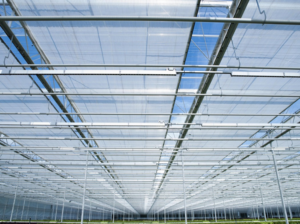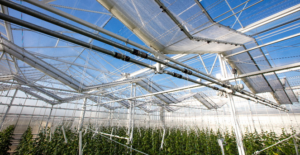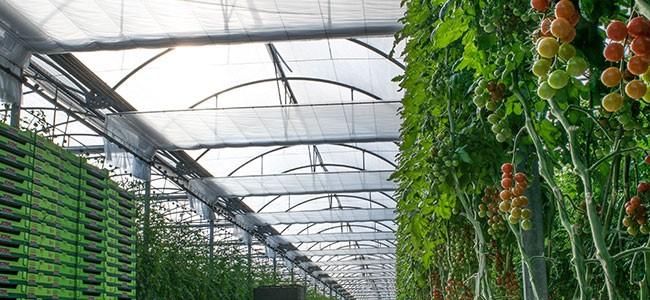Energy/shade screen systems are one of the most common conservation measures to find finance for. With a payback of two to four years, these systems provide a good return on the money invested. They are most common in gutter-connected greenhouses but can also be installed in free-standing greenhouses.
Energy/shade screen systems can provide 30 to 50% savings in heating or cooling costs. Often referred to as energy blankets, they save energy by reducing the heat loss surface area, providing an extra insulation barrier and trapping a layer of dead air on both sides of the screen material.
An energy/shade screen is a mechanical system consisting of a drive motor, support cables, energy/shade material and controls. A gear motor is needed to power the drive system. One motor can handle up to an acre of screen.
Choosing the Best System
Gutter to gutter or side to side systems require less material but form a larger bundle in the storage position. They are easier to install as work is done at a lower height. With this system, equipment and plants cannot be supported from the lower truss cord.
Truss to truss systems are more common. They can be configured flat at the lower cord of the truss or formed into a slope-slope or slope-flat-slope shape to follow the roof of the greenhouse. The latter two may allow heating, lighting and watering equipment to remain in place without having to move it. Flat systems reduce the volume of greenhouse that has to be heated.
Correct Screen Material
The most common materials for energy screens are composite fabrics of alternating strips of clear and aluminized polyester or acrylic held together by a finely woven mesh of threads. Other materials include knitted and woven bonded polyester, metalized high density polyethylene and polypropylene. Look for the warranty life (usually 5 to 10 years), strength and flexibility.

Many screen materials are designed to provide summer shading. For comparison, manufacturers list both the shade factor and the energy savings. Shade levels from 5 to 90% are available with the most common being 40 to 60%.
Screens can also have an open weave or closed weave. The closed weave has a higher energy savings and is used in greenhouses with fan ventilation systems. For natural ventilation, an open weave allows the heat to rise through the screen when it is extended. Some growers install a closed weave to get the high energy savings and then crack the screen open to allow the summer heat to escape up through the vents.
For production, a good choice of screen material is the Tempa 5557 D FB which is made of 4 mm wide aluminium and polyester strips held together with a polyester filament yarn. The aluminium reflects the heat back into the greenhouse at night during the winter and reflects the sun’s heat out of the greenhouse during the summer days. The yarn allows moisture to go through, reducing condensation and dripping.
The Tempa 5557 material has a 45% direct light transmission, 43% diffuse light transmission and 57% energy savings and is used for closed roof greenhouses. For house plants and other shade loving plants a material with more shade should be used. A Tempa 6562 D may be a better choice as it has 65% shade and 62% energy savings.
Cost
The cost of a screen system depends on the size of the installation, screen material used, number of obstructions that have to be worked around and ease of manoeuvring man-lifts in the greenhouse. Additional cost may result from having to move heating, cooling, lighting or irrigation equipment out of the screen area.
System Control
Deciding when to open and close the screen can be done several ways. The simplest is manual control, basically a switch that turns the gear drive motor on. The disadvantage is that someone has to be around to make the decision on when to activate it. As with other control devices such as heaters or vents, this decision may not always be made at the best time.
These decisions can also be made by controls that are based on time of day, light level, greenhouse temperature, humidity level or all of these. Controllers have been developed that integrate some or all of these functions.
A clock is incorporated to open and close an energy screen base on sunrise and sunset. It is adjusted weekly to account for the lengthening or shortening of the day length. A photo sensor is included to activate the system when the light level inside the greenhouse reaches a pre-set level either too low during the winter or too high during the summer.
Temperature and humidity sensors may be included to provide control when pre-set levels are reached. A weather station is needed to provide outdoor light level, temperature, humidity, wind and rain or ultra-cold conditions.
Control Parameters
Based on the above, the grower is required to enter these parameters into the controller: Start time – when in the morning will the screen system start operation, stop time – when in the afternoon will the screen system stop operation, light level – at what light intensity will the screen be activated either to open or close, maximum/minimum temperature – what are the limits of temperature desired, maximum/minimum humidity – What are the limits of humidity desired.

Also important are gap positions – this sets the per cent open or close position under different conditions such as early on a winter morning to reduce thermal shock or during the summer to provide better shading. The gap steps and speed of movement can be controlled in some systems.
Under changeable weather conditions a time delay avoids frequent opening and closing. Wind speed: to reduce heat loss, the screen can be closed early under high wind speed conditions. Ultra-cold conditions control – this can open the screen and turn on the heat when extra low temperatures is experienced.
The standard system uses nylon monofilament or stainless steel cables to support the screen material. The screen material can either rest on top of the network of cables or be suspended by hooks from the cables. A gear motor powers a drum or rack and pinion that moves the leading edge of the screen material. Control is either with a manual switch or electronic controller.
Installation and Maintenance
A screen system is easiest to install if the greenhouse is empty of plants. Man-lifts are frequently used to elevate workers to the truss level and require space to maneuver. Heat supply pipes that are above the screen have to be insulated or moved lower. Vent arms, water pipes, light fixtures and electrical wiring may also be in the way. The screen system requires a clear vertical area of at least 30cm.
Closed weave energy screens need to be installed to provide a tight seal all the way around the edges. The most common method is to install a narrow ledge along the sidewall made from polycarbonate sheets or fire-resistant screen material. The side edges of the screen slide along the top of this ledge. The back edge is attached to the truss and the leading edge is attached to rigid tubing that seals the screen against the truss.
Regular maintenance is needed to keep proper tension in the cable system. Pulleys and gear motors should be lubricated once or twice a year. Screen materials tend to wear at the rub points or where they are supported by hooks. Repairs may have to be made at these points. Source: Various manufacturers

